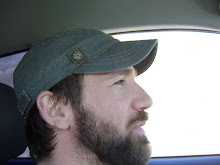Of course, the incredible deeds of Petit are recently brought to my attention by the Oscar-winning documentary “Man on Wire.” And I could certainly be writing this blog about that film as a perfect documentary. Director James Marsh did a fantastic job of telling the story, but I suspect that Marsh himself would be the first to tell you that, even though his story-telling is perfect, the power of his film is entirely wrapped up in the person of Philippe Petit and his perfect unequivocal act.
In 1974, 25-year-old Petit and a rag-tag group of accomplices managed to break into the
It took Petit and his friends six years to plan. The obstacles were many and formidable. How would they get their hundreds and hundreds of pounds of equipment to the roof? How would they cope with the wind and mist? How would they get by the guards? How would they get the cable across the immense distance? (By the way they decided to use a bow and arrow for this last bit).
My first thoughts upon hearing about this are probably the same things you are thinking right now. Why did he do it? Who would help a man do something so clearly dangerous and illegal?
Petit himself is irritated by the question “why,” and sees it as stupidly American. In one interview he said simply, “When I see oranges I juggle them. When I see towers I walk on a wire.” I think that part of what made this adventure worthwhile for him was the caper aspect of it: the illegal scheme. As one of his associates remarks, Petit liked to do things that are illegal but not evil, not malicious. It was like a bank-robbery without victims. They called the plan “Le Coup.” It was a decisive and somewhat subversive.
One of my favorite scenes from the film is when you see one of the police officers describing what his experience. This man stood at one end of the wire, trying to get Petit to step back onto the building. He speaks as a representative of conventional authority, one who enforces rules, and he certainly tried to do this with Petit. But even as he describes Petit, you see the awe in his eyes and his voice. He is clearly moved by what he saw. He is forced (to some extent anyway) to take account of his previously comfortable way of looking at things. What does a law man do about this kind of crime with no victims? A crime so beautiful and daring? This is the subversiveness of Petit’s act: not political, supporting some “cause” or another, but fundamental. He stood for forty-five minutes over a chasm that might as well have been
So who were these people that helped him? It was a strange crew, including a few long time French friends of Petit (some of whom helped him in his earlier schemes, for example when he walked a wire between the Notre Dame towers), one Australian, his French girlfriend, two pot-smoking American hippies, and one upper middle class, suit-wearing businessman who worked in the WTC. Petit had the charisma and singularity of vision to inspire such diverse people to devote themselves to his vision completely. Young mena dn women of talent, often with much to lose, risking it for this crazy Frenchman’s suicidal dream.
Part of his persuasiveness was his undeniable talent as a tightrope walker. One associate, Albert, says that he was convinced to join the firs time he saw Petit walk a wire. When he stepped out on a wire, “his face became an ageless mask of concentration.” Albert admits that he has never seen anything like it since. “His face became like a sphinx.”
Petit admits that as he stepped onto the wire that he thought he was probably stepping out to probably the end of his life. “Death was very close.” His best friend and number-one accomplice remembers his anxiety as he watched from the opposite tower as Petit first walked onto the wire. He could see the nervous concentration on Petit’s face. Petit slowly edged out into the middle of the void, testing carefully each step. Then Petit’s expression changed. He smiled. His friend weeps even now, retelling the relief he felt.
There is a photograph of the event from the ground. You can see Petit on the wire and in the background is a plane either taking off or landing at JFK. It seems in the photo that Petit is closer to the plane than he is to the people on the ground. The distance is so great, that even photographs from that height make me a little dizzy.
Petit’s act lacks anything remotely approaching wisdom. It is so stupid really. But what can we roughly compare this to? It approaches has the daring of Magellan or Neil Armstrong. Could those men have been in any more danger than Petit? Could they have had doubts greater than he, any more certainty that their crazy explorations would not end in their own death? It approaches the grandeur and scale of Galileo dropping two stones with different masses from
No comparison is fair. This is exactly what makes it unequivocal. I wonder if Kohelet had stood on the top of one of those towers on
“It seems obvious to me that life should be lived on the edge of life, to exercise rebellion, to refuse to repeat yourself, to live on a highwire.” Phillipe Petit
